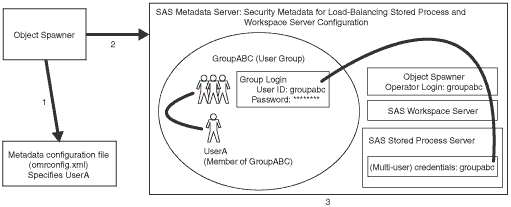SAS 9.1.3 Integration Technologies » Server Administrator's Guide
|
Security
Scenario: Security Configuration for Spawner and Load-BalancingThe following scenario shows a recommended setup for spawner and server security. In this scenario, an object spawner runs on the server host, monitors client requests for the stored process and workspace server, and connects clients to the appropriate server process. (For a scenario that shows how to set up load-balancing security across spawners, see Scenario: Security Configuration for Load-Balancing SAS Stored Process Servers Across Two Machines). The SAS Metadata Server contains the spawner, server, and security metadata for the load-balancing stored process server and workspace server configuration. The object spawner must connect to the SAS Metadata Server, and the metadata must be appropriately configured to enable the spawner to start the load-balancing stored process server or workspace server. Note: The users and groups that are used in this example correspond to the users that are set up in an Advanced or Personal installation as follows:
The following diagram shows the initial security setup and process flow for the load-balancing stored process server, workspace server, and spawner configuration: Note: On Windows, all user IDs would be machine- or domain-qualified. For example,
 In the previous diagram, the Object Spawner obtains the metadata information to start a load-balancing stored process server or workspace server as follows:
The object spawner then has the necessary metadata to launch a workspace or stored process server. The following diagrams show the flow for a client request and a stored process server or workspace server launch.  
Note: Because the stored process server runs under the credentials for the multi-user stored process server, each client can only access information for which the multi-user credentials are authorized. |